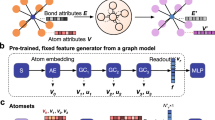Abstract
It is widely acknowledged that artificial intelligence (AI) technology has been extensively applied and has achieved remarkable advancements in various fields. The field of computational materials science has also embraced AI techniques in diverse ways. Today, computational materials science plays a crucial role in the development of cutting-edge materials, including pharmaceuticals, catalysts, semiconductors, and batteries. One significant task in this field is the regression of the total energy of atomic structures that form various materials. In this study, we propose a modified model architecture aimed at improving the performance of existing total energy regression models. Traditional total energy regression models calculate the total energy by summing the energies of individual nodes represented in the atomic structure graph. However, our approach suggests a modified architecture that not only predicts the energy for nodes but also incorporates energy prediction for edges in the graph. This novel architecture achieved a 3.9% reduction in energy error compared to the base model. Moreover, its simplicity provides the advantage of general applicability to other total energy regression models.
Access this chapter
Tax calculation will be finalised at checkout
Purchases are for personal use only
Similar content being viewed by others
References
Butler, K.: Machine learning for molecular and materials science. Nature 559, 547–555 (2018)
Schmidt, J.: Recent advances and applications of machine learning in solid-state materials science. npj Comput. Mater. 5, 83 (2019)
Wei, J.: Machine learning in materials science. InfoMat 1, 338–358 (2019)
Morgan, D.: Opportunities and challenges for machine learning in materials science. Ann. Rev. 50, 71–103 (2020)
Fiedler, L.: Deep dive into machine learning density functional theory for materials science and chemistry. Phys. Rev. Mater. 6, 040301 (2022)
Ladha, D.: A review on density functional theory-based study on two-dimensional materials used in batteries. Mater. Today. Chem. 11, 94–111 (2019)
Adekoya, D.: DFT-guided design and fabrication of carbon-nitride-based materials for energy storage devices: a review. Nanomicro Lett. 13, 13 (2021)
Liang, Q.: Transition metal compounds family for Li-S batteries: the DFT-guide for suppressing polysulfides shuttle. Adv. Funct. Mater. 33, 2300825 (2023)
Neugebauer, J.: Density functional theory in materials science. WIREs Comput. Mol. Sci. 3, 438–448 (2013)
Mattsson, A.: Designing meaningful density functional theory calculations in materials science-a primer. Model. Simul. Mat. Sci. Eng. 13, R1 (2005)
Tandon, H.: A brief review on importance of DFT in drug design. Res. Med. Eng. Sci. 7, 791–795 (2019)
Sade, V.: Current trends in computer aided drug design and a highlight of drugs discovered via computational techniques: a review. Eur. J. Med. Chem. 224, 113705 (2021)
Weijing, D.: The application of DFT in catalysis and adsorption reaction system. Energy Procedia 152, 997–1002 (2018)
Liao, X.: Density functional theory for electrocatalysis. Energy Environ. Mater. 5, 157–185 (2021)
Hohenberg, P.: Inhomogeneous electron gas. Phys. Rev. 136, B864 (1964)
Kohn, W.: Self-consistent equations including exchange and correlation effects. Phys. Rev. 140, A1133 (1965)
Zhang, L.: Deep potential molecular dynamics: a scalable model with the accuracy of quantum mechanics. Phys. Rev. Lett. 120, 143001 (2018)
Chandrasekaran, A.: Solving the electronic structure problem with machine learning. npj Comput. Mater. 5, 22 (2019)
Tran, R.: The Open Catalyst 2022 (OC22) dataset and challenges for oxide electrocatalysts. ACS Catal. 13(5), 3066–3084 (2023)
Behler, J.: Generalied neural-network representation of high-dimensional potential-energy surface. Phys. Rev. Lett. 98, 146401 (2007)
Bartók, A.: Gaussian approximation potentials: the accuracy of quantum mechanics, without the electrons. Phys. Rev. Lett. 104, 136403 (2010)
Artith, N.: An implementation of artificial neural-network potentials for atomistic materials simulations: performance for \(\rm TiO_2 \). Comput. Mater. Sci. 114, 135–150 (2016)
Schütt, K.: SchNet - a deep learning architecture for molecules and materials. J. Chem. Phys. 148, 24 (2018)
Lee, K.: SIMPLE-NN: an efficient package for training and executing neural-network interatomic potentials. Comput. Phys. Comm. 242, 95–103 (2019)
Gasteiger, J.: GemNet-OC: developing graph neural networks for large and diverse molecular simulation datasets. arXiv preprint arXiv:2204.02782 (2022)
Zelinsky, N.: A neural device for searching direct correlations between structures and properties of chemical compounds. J. Chem. Inf. Comput. Sci. 37, 715–721 (1997)
Gasteiger, J., Becker, F., Günnemann, S.: GemNet: universal directional graph neural networks for molecules. In: 35th Conference on Neural Information Processing Systems, vol. 34, pp. 6790–6802 (2021)
Acknowledgement
This research was supported by Basic Science Research Program through the National Research Foundation of Korea (NRF) funded by the Ministry of Education (NRF-2021R1I1A3A04036408) and also supported by Institute of Information & communications Technology Planning & Evaluation (IITP) grant funded by the Korea government (MSIT) (No. 2021-0-02068, Artificial Intelligence Innovation Hub).
Author information
Authors and Affiliations
Corresponding authors
Editor information
Editors and Affiliations
Rights and permissions
Copyright information
© 2023 The Author(s), under exclusive license to Springer Nature Switzerland AG
About this paper
Cite this paper
Yeo, K., Jeong, S., Kim, SH. (2023). Edge Based Architecture for Total Energy Regression Models for Computational Materials Science. In: Lu, H., Blumenstein, M., Cho, SB., Liu, CL., Yagi, Y., Kamiya, T. (eds) Pattern Recognition. ACPR 2023. Lecture Notes in Computer Science, vol 14408. Springer, Cham. https://doi.org/10.1007/978-3-031-47665-5_9
Download citation
DOI: https://doi.org/10.1007/978-3-031-47665-5_9
Published:
Publisher Name: Springer, Cham
Print ISBN: 978-3-031-47664-8
Online ISBN: 978-3-031-47665-5
eBook Packages: Computer ScienceComputer Science (R0)




